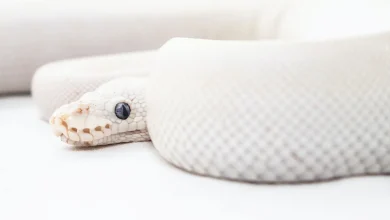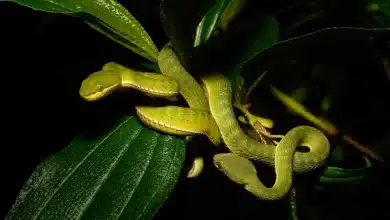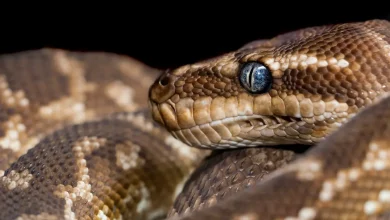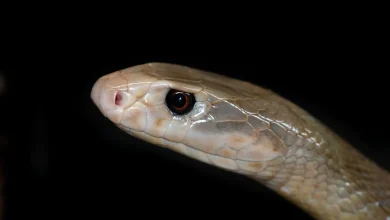How To Identify Snakes in Thailand and the World?
Here is a page full of tips that will help you to identify snakes all over the world, but I’ve talked about snakes here in Thailand as examples.
There are a number of variables you can focus on when looking at a snake you see in your yard and you are trying to figure out if it’s dangerous to you, or not. Thailand has more than 37 venomous and dangerous terrestrial snakes that can put you, your children, or your pets in a hospital.
Though it’s impossible to teach you all of the identifying features that make up the more than 230 snake species in Thailand, we can show you what to look for when you have that 5-second glance at a snake that disappears before you can even click a photo. If at all possible, DO get a photo or video because anything visual you can show us to help identify the snake will be very helpful. See this Snake Identification page to get your snakes identified.
Features of Snake Identification
These are the areas that can help to identify a snake, so you should try to pay attention to these things when you see a snake in your yard, car, house, garage, tree, shoe, or wherever it ends up!
Snake Color
The color of the snake can help to identify a snake, though it probably isn’t the best singular variable we have in snake identification. Snakes of the same species can vary in color pretty dramatically. There are pink-tinted Malayan Pit Vipers, and there are very dark brown ones. In this case, telling us you saw a pink snake may not be all that helpful!
Other snakes have little variation in their overall scale color, and this can help us to identify the snake easier. Snakes like the Red-tailed Racer, Golden Tree Snake, and the Indo-Chinese Rat Snake all tend to be about the same coloration and hue with little differences. If you tell us you saw a green snake in a tree, the Red-tailed racer would immediately be on the list of possibilities.
Snake color can vary from head to tail, so if you see a green snake that is green from the head to the tail, that can tell us something and help us eliminate many of the green pit vipers that have a brownish or reddish tail.
Some snakes have different colored heads compared to their body. The Red-necked keelback has a green head and yellowish and red colored neck and body. The Red-headed Krait has a red head and tail. The red-headed Coral snake has a red head and tail. The Green Keelback has a pink head and greenish body when young, and a green head when adult.
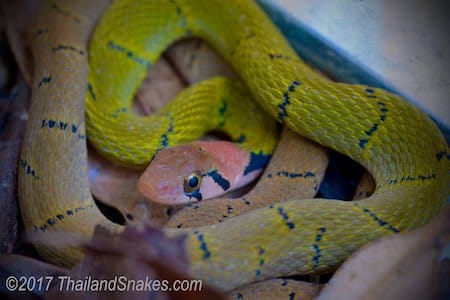
Head color is a great characteristic to notice if you can see that it differs from the snake’s neck or general body color or pattern.
Green Snakes
Snakes that prefer grass and tree habitat tend to be an overall green color, or at least have some green color. Snakes that fit this are Red-tailed Racers, Red-necked Keelback, Green Banded Keelback, Oriental Whip Snake, all Green Pit Vipers, Green Rat Snake, Golden Tree Snake and Paradise Tree Snake, and Green Cat Snake.
Black and Brown Snakes
Black and brown snakes can usually be found on the ground. This encompasses rat snakes in the Ptyas genus, most kukri snakes, some wolf snakes, and the cobras. Black and brown snakes can be really difficult to see at night and when they’re moving over branches, leaves, dirt, and mud.
Key Takeaways
So, when looking at snake color – try to take note of whether the color is consistent across the entire head and body, and tail, or if it varies in some way. This will help greatly in identifying the snake.
Snake Patterns
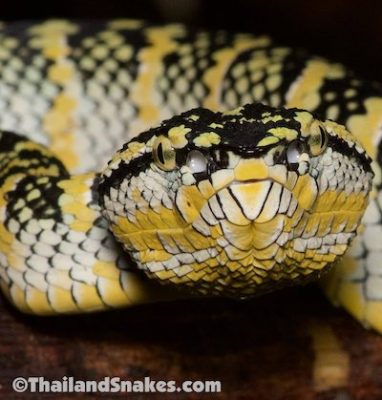
The pattern seen on the snake is the best indicator of which snake species it is. The problem is, it is rare that someone can accurately describe the pattern because the general public is not knowledgeable about common patterns and how to describe them.
Patterns can be lines going in checker patterns or diagonals, triangles, blotches, circles, ovals, speckles, or just about anything else. It’s hard to describe most intricate snake patterns.
Bands Across the Body
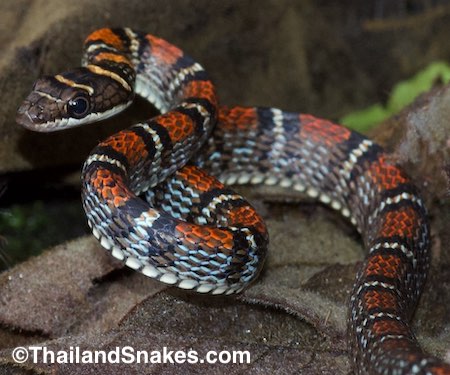
A band on a snake is like a belt worn by a human. It goes around our waist – our girth – and it may extend onto the ventral surface (belly) or stop at the lateral (side) of the snake.
If you can see bands on a snake, this can be very helpful in identifying the snake. Try to notice where the bands start and end. Do they go the entire way across the head? This could be a juvenile King Cobra. Do the bands appear only around the mid-body and all the way to the tail? This may be a Banded Rat Snake.
Try to notice the thickness of the bands too so you can describe the size in some meaningful way. A Banded Krait has very thick black bands that are nearly equal to the size of their yellow bands. A Bridle Snake has thin white bands with a large space between them.
Stripes Down the Body
A stripe runs the length of the body, or if not that long, in the direction from the head towards the tail. Stripes can be of different colors on different snake species and can be the full length of the body and even the head, or just appear on some section of the body like the neck, the mid-body, or the tail.
Stripes are a great factor to notice because they can help us identify snakes quicker.
Head Pattern
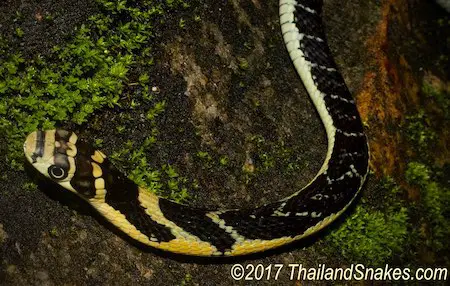
Some snakes have a pattern on the top of the head, or on the side of the eyes like a dark line going toward the neck. Juvenile king cobras have very distinctive black-colored bands running across the top of the head. Kukri snakes can have intricate patterns on their heads. The Wagler’s Pit Viper and Brown-spotted Pit Vipers can both have the same intricate pattern on their head as is evident on their body.
Head patterns are usually too small to see unless you’re really close to a snake.
Neck Pattern

Sunbeam and Common Wolf Snakes have a white ring around the neck that disappears as they mature to adults. There are no other bands or rings down the entire body of that snake, so this identifying characteristic is a good one to notice.
Monocled Cobras have a distinctive “monocle” shape on the back of their necks that is only evident when they flare the neck (hood).
Neck patterns can help a lot when trying to figure out which snake species you’ve seen.
Tail Pattern

There are some tail patterns you may notice, but when a snake is moving, you’re very unlikely to be able to discern a pattern on the tail, the smallest (thinnest) part of the snake.
With King Cobras and Keeled Rat Snakes, they have distinct scales on the tail and you may notice this difference when the snake is still. The tail pattern isn’t something to pay too much attention to. Tail coloration is more telling in some cases.
Key Takeaways
To see the pattern on a snake may be difficult or impossible in a state of fear where all you want to do is protect yourself. Don’t go closer to see the pattern, just see what you can from a safe distance.
A mobile phone camera or another camera can help immensely to zoom in to see the pattern better and record it if you can.
Length of Snake and Girth
Snake Length
The length of the snake is more telling the longer it is. The reason for that is that every snake starts out much smaller and can grow to multiples of its juvenile state to adulthood. The king cobra starts out as a 50 cm long hatchling and can grow to 5.85 meters long. That’s nearly 12 times the length it started at.
So, we can say all snakes begin life under 1 meter in length. If you see a snake and that’s all you can tell us, the chance of a good ID is not so great, even if you tell us it was at night in water with a frog in its mouth. There are just too many snakes it could be.
Where length helps to identify snakes more is when the length gets over 1 or 2 meters. Few snakes grow to lengths over 2 meters long. Even fewer reach 3+ meters. There are only a handful that reach over 4 meters in length, so identification of longer snakes is usually a bit simpler.
Snake Girth
The thicker around the body (in circumference) a snake is, the easier it can be to identify too. There are few snakes thicker than a man’s thigh, so if you see one, it can probably be identified fairly easily. I can only think of three snakes that would qualify: Javan File Snake, Reticulated Python, and the Burmese Python.
Think of snake girth in relation to things that people know the size of like a pencil, adult finger, banana, wrist, forearm, cucumber, thigh, etc.
Body Girth vs Neck Girth
Many snakes have a noticeable difference in the thickness of the neck thickness in relation to the body and/or head size. You may notice a much thinner neck area leading to a pronounced head. This can help greatly in identification, but it’s one of those factors that most people won’t see without a long look at the snake.
Patterns, colors, and thickness can usually be estimated better with longer and thicker snakes too – so all of this goes into the fact that bigger snakes are easier to identify.
Key Takeaways
When you see a snake, try to quickly estimate its length in meters. Think of your own height and whether if you laid down beside it where it would come to on you. Or, look at whatever the snake is on and try to remember where it started and ended so you can measure that area later.
Snake thickness can help a lot to identify snakes and help eliminate others. If you saw a brown snake on the ground with a thin neck, a big head, and it was about 4 fingers thick, the Malayan Pit Viper would immediately come to mind if the snake was under 1 meter long. Rat snakes and cobras would come to mind if the snake was well over a meter long.
Snake Head Shape
The shape of a snake’s head is very subjective and a hard variable to distinguish from a distance, or even close up sometimes. This isn’t one you should pay too much attention to.
There are many graphics making the rounds on social media that purport to tell you easy ways to know if a snake is venomous and dangerous, or not. The problem is, they very rarely ever state the area the rules are applicable to.
In the USA, our venomous snakes all have big, triangular heads with the exception of coral snakes. Then we have a pattern about the red, yellow, and black bands saying, “Red touching yellow, hurt a fellow” for venomous corals because there is another harmless snake, the Scarlet King, that has very similar bands but the yellow bands never touch the red.
This generalization does NOT apply to snakes in Thailand and Southeast Asia. We have kraits, cobras, coral snakes, and a keelback that do not have anything resembling a triangle-shaped head. Then we have cat snakes that have quite triangular heads but are harmless to humans.
Please don’t pay any attention to graphics like this!
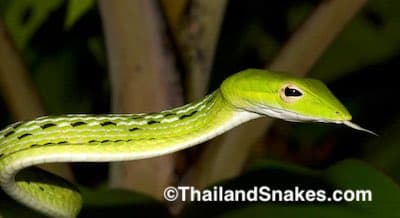
One way we can identify snakes by the head shape is in the case of the Oriental Whip Snake or Long-Nosed Whip Snake. They both have an elongated head that is very distinctive.
Key Takeaways
Head shape can help to identify snakes, but untrained observers are likely to see snakes in a different way than someone who has a good working knowledge of the snakes in the area. If you can obviously see a big triangular head, do let the experts know because any piece of data is helpful in identification.
Location
The province and even the area of the province can help us to identify snakes that have a small range. Other snakes are found across the entirety of Thailand and knowing where it was found won’t help us much to ID it.
Where the snake is found, in the type of habitat, and on what surface can also give us clues to find out which snake species it is. Note whether the snake was on a tree 2 meters off the ground, or on the ground next to a stream. If the snake was coming out of a hole in the ground or on a tree, that too can be important.
Snakes in Water
Some snakes seek out streams, lakes, or puddles to soak in so they can more easily shed tight skin. Pythons are well known for this, and they are one of the biggest snakes in Thailand so they are easy to see soaking in the water.
Some snakes are known to favor the water and will be found there most often. Snakes like the Triangle Keelback, Puff-faced Water Snake, Rainbow Water Snake, and Pipe Snakes all favor the water environment for hunting prey.
Snakes in Trees
Some snakes spend most of their time in trees like the Oriental Whip Snake, Paradise Tree Snake, Twin-barred Tree Snake, Red-tailed Racer, Cat Snakes, and Keel-bellied Whip Snakes. Other snakes will go to the trees occasionally like King Cobras, Rat Snakes in the Ptyas genus, and Monocled Cobras.
Some snakes will never be found climbing up a tree, so this factor can help us eliminate some snakes and nominate others.
Snakes on the Ground
Of course, most snakes can be observed on the ground during some part of their life cycle, so if you do see one there take note of whether they are on leaves, mud, rocks, by the ocean shore, by a lake shore, on a dried-up stream, on old palm branches, etc. Any little detail can help!
Key Takeaways
The area of Thailand and the type of habitat the snake is found in and on is important and can help distinguish some species from others. Snakes have a range of distribution which is never well-marked in books or studies but can be a good approximation. The type of habitat they are seen in can be quite helpful.
Time of Day
Many snakes have a time period where they are active and a period where they are dormant. Some snakes like Monocled Cobras and King Cobras can be found to be active any time they are hungry. Snakes like Bridle Snakes, Laotian Wolf Snakes, and sunbeam snakes only seem to be active at night. Other snakes like rat snakes, bronzebacks, and tree snakes are only active during daylight hours.
Weather
The weather occurring at the time can also be a good clue because some snakes like vipers can be crepuscular and come out during early morning, early evening, and during times of dense cloud cover that resembles these times of day.
When the rain is falling, there are few snakes at night that venture out to find prey. The snakes I do find consistently in rain are Reticulated Pythons, Cat Snakes, Laotian Wolf Snakes, Sunbeam Snakes, and Malayan Kraits.
Key Takeaways
Some snakes are more active during some parts of their active period every day. Monocled Cobras seem to be most active in the heat of the day between 2 pm. and 4 pm. I have consistently seen more cobras cross the road on a hot day at 3 pm. than at any other time. It’s uncanny.
Snake Behavior
Snakes can be active – awake and moving or hunting for prey – or they can be sleeping and inactive. What the snake is doing at the time can be important information for making an educated guess about the species of snake.
Eating Prey
If you can notice what type of prey the snake is eating, that can be helpful. I mean, there aren’t too many snakes that would be eating a goat or a hog badger, so knowing this info can aid dramatically in identification!
If you can see a snake eating a frog, lizard, skink, bird, rat, another snake, or anything, don’t forget to mention that to experts trying to identify the snake.
Strike Preparation
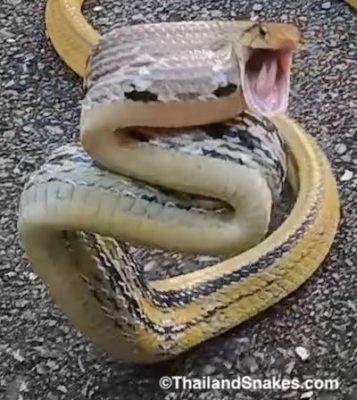
When snakes are ready to strike, they have a characteristic shape that can be observed for their species. Laotian Wolf Snakes have a very distinctive off-the-ground s-shape in which they tilt their body to look quite odd. Cobras flare their hoods. Vipers coil to strike. Radiated Rat Snakes pull back into a double s-shape before striking.
If you can describe anything like these behaviors, it can contribute to a positive ID.
Vocalizations and Noise Making
Some snakes make audible noises as a defense mechanism. King Cobras have a deep growl as a warning, and sometimes their breath comes out very forcefully. Monocled Cobras, Burmese Pythons, and Keel Rat Snakes all have a very audible hiss when provoked.
Other snakes like the Malayan Pit Viper and some cat and wolf snakes will rustle the leaves or just shake their tail as if they are a rattlesnake when they are confronted and don’t feel safe. The threat display of a wiggling tail can distract the aggressor and make for a better strike by the snake.
Key Takeaways
What the snake is doing at the time of the sighting or while preparing to strike at you can be important information you should remember.
A Note on Observing Snakes for Identification
Snakes are afraid of humans, they have no interest at all in coming closer to us when not provoked. If you see a snake, back away slowly until you’re a few meters away. The bigger the snake, the further away you should be. For a large king cobra, 10 meters or so is about right.
Though you are some distance away, snakes may still come toward you as they either don’t notice you or are heading toward some area they want to go. They may be in a sort of panic and their brain tells them that that dark space over by your right leg is the best place to go to escape. This can happen. Of course, you’ll be afraid and think the snake is coming from a far distance to bite you. It almost surely is not if you are at least 4-5 meters away.
Snakes notice movement. If a snake is coming toward you, flail your arms and move around so it sees you. Before you do this, it may not even know you’re there.
Try to observe the snake characteristics we covered above. If you can relay a few of the identifying factors, we can narrow the snake’s species down to either one snake or just a couple. Of course, the more information you can give, the better.
Remember, snakes don’t want to hurt you or even SEE YOU. Make some noise and movements to scare them away when you are far enough away.
(All images ©Vern Lovic at ThailandSnakes.com)

